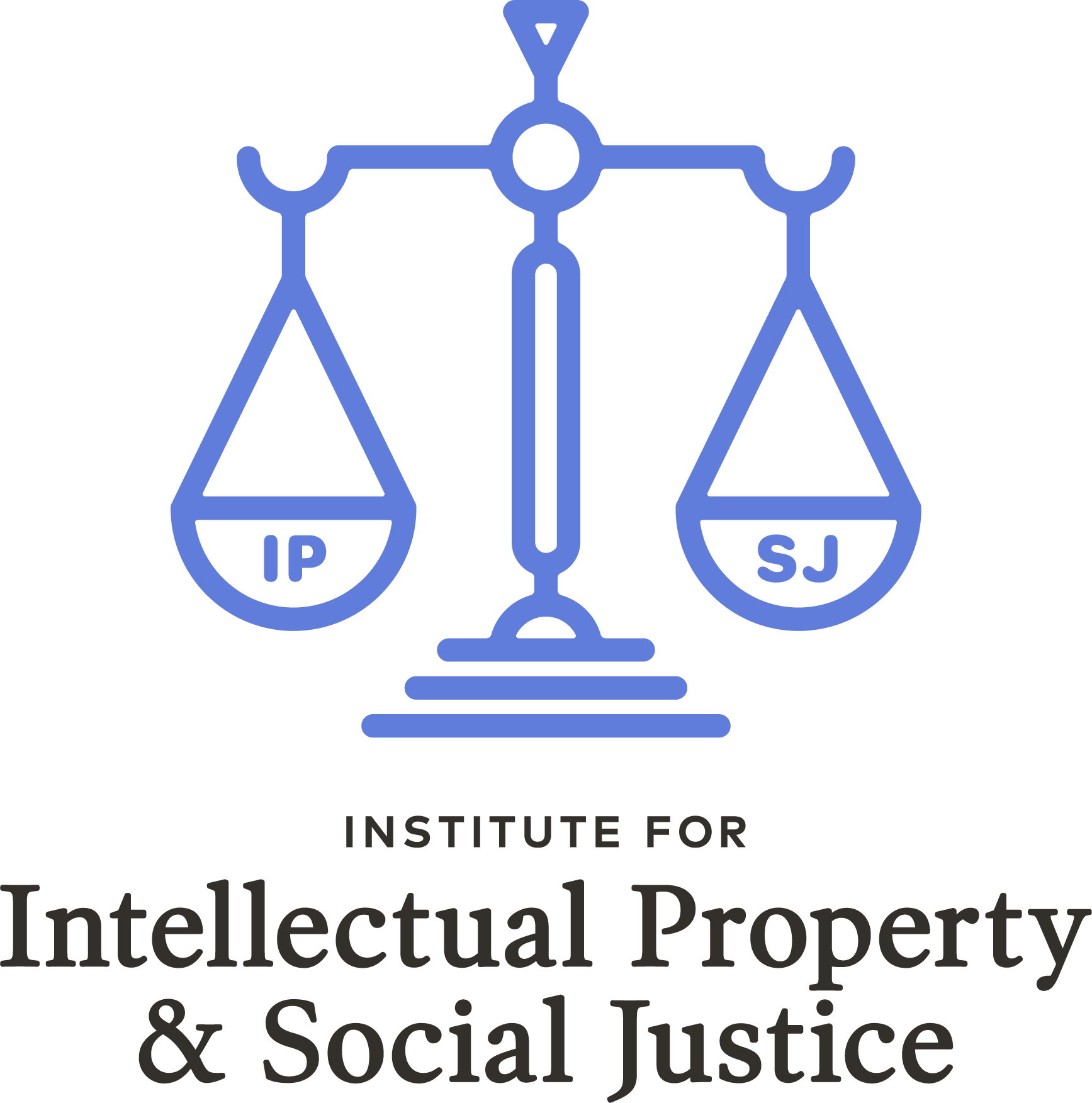MMA
Update on the Passage of the Music Modernization Act
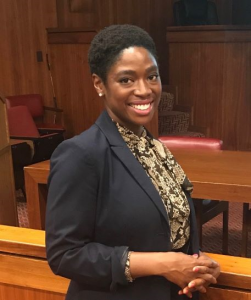 - Idia Egonmwan, a 2L student attorney in the Intellectual Property Clinic at Howard University School of Law.
- Idia Egonmwan, a 2L student attorney in the Intellectual Property Clinic at Howard University School of Law.
As many of our membership will recall, earlier this year IIPSJ submitted to Congress both formal comments and also a letter on behalf of intellectual property law and other scholars to support passage of the Compensating Legacy Artists for their Songs, Service, and Important Contributions to Society (CLASSICS) Act and the Music Modernization Act (MMA), and otherwise undertook a public campaign in support of these legislative bills. We are pleased to report that these and other grassroots and other efforts were successful and both acts were passed by Congress on September 18, 2018 (combined into a revised Music Modernization Act) and signed into law by President Trump on October 11, 2018.
What is the Music Modernization Act (MMA)?
The MMA mitigates many of the economic and social inequities perpetuated in the music recording business by creating uniformity in legal protection for pre- and post-1972 sound recordings via the federal copyright system.[1] The MMA is broken into three parts:
- Title I establishes a musical licensing collective to issue and administer blanket mechanical licenses for the use of sound recordings to digital music services and to and collect and distribute royalty payments directly to rights owners, including performing artists;
- Title II compensates pre-1972 sound recording artists by creating a royalty structure; and
- Title III creates a legal right for various musical contributors (producers, mixers, and sound engineering) to collect royalties for digital transmissions of sound recordings.[2]
The IP Social Justice Impact of the MMA
African American and other marginalized creators and artists have historically suffered from legal and social limitations upon their freedom to contract, inequities exacerbated by the systemic manipulation and abuse of the copyright law and music sound recording contracts and licensing agreements. “Legacy” recording artists such as Otis Redding, Martha Reeves and the Vandellas, and the Temptations were especially disadvantaged in that copyright protection did not extend to pre-1972 sound recording.[3] As a result of the passage of the MMA, composing artists will benefit from more equitable royalty structures under the Copyright Section 115 compulsory mechanical (recording) license (which historically exploited the inferior bargaining power of all artists, but particularly artists of color) (Title I); limited music copyright protection in the form of a digital performance right has been extended to pre-1972 “Legacy” sound recording artists (Title II); and a right for previously uncompensated producers, mixers, and sound engineers to collect royalties for their creative contributions has been established. (Title III).
Fair Compensation and IP Social Justice for Music Creators and Performers
The Music Modernization Act (MMA) is a progressive step for copyright law and the American recording industry, ultimately providing legacy, current, and future musical artists with more equitable compensation for creating, sharing, and performing their work. Utilizing intellectual property as a means of social justice in the music industry is a small subset of how IP law can be used to empower and rebuild marginalized communities. Although not perfect, the MMA represents the outcomes that can be achieved when legal scholars, legislators, and intellectual property and other social justice activists collaborate to preserve the purpose of copyright and other intellectual property law: to promote and encourage socially equitable and beneficial creative labors.
[1] See the Letter from Lateef Mtima, Dir., Institute for Intellectual Property & Social Justice, to Chuck Grassley, Chairman, U.S. S. Comm. on the Judiciary, Dianne Feinstein, Ranking Member, U.S. S. Comm. on the Judiciary, Bob Goodlatte, Chairman, U.S. House of Rep. Comm. on the Judiciary, Jerrold Nadler, Ranking Member, U.S. House of Rep. Comm. on the Judiciary (Mar. 14, 2018)
[2] See Mark Wittow, A Modern Melody for the Music Industry: The Music Modernization Act Just Passed Congress and Awaits Presidential Approval, The Nat’l Law Review (Oct. 2, 2018), https://www.natlawreview.com/article/modern-melody-music-industry-music-modernization-act-just-passed-congress-and-awaits
[3] Id.
July 2018
|
|
|
|
IP Mosaic
The IIPSJ MOSAIC IP Law and Policy Roundtable Conference
Purpose and Objectives
The IIPSJ Mosaic Roundtable Conference was established to bring together scholars, law and policy makers, and social activists of diverse and multicultural backgrounds and perspectives to explore progressive and non-traditional ideas in intellectual property law, policy, and social activism. Beginning in the late twentieth century, digital information technology and other innovations sparked a paradigm shift in scholarly assessment of the social ordering function of IP protection, exposing the need to critically examine the law’s social justice obligations in promoting human rights, self-determination, cultural progress, and nation-building and evolution. Because IP law and policy makers traditionally value scholarly analyses in their development and interpretation of IP protection, this emerging body of progressive, social justice-oriented IP scholarship, especially when infused with the experience and insights of social activists and policy makers, can provide them with the doctrinal basis for shaping a more socially responsible IP legal regime.
The Mosaic Roundtable Conference Format
Each Roundtable Conference is organized around a specific IP social justice legal issue, policy, or socio-economic problem, and is comprised of four paper or project presentation sessions; each session is divided into a principal presentation, a commentator’s assessment, and open discussion. Representative Roundtable topics include equitable access to health, medicines, knowledge, and information; socially beneficial application of information technology and related advances to IP development and dissemination; legal protection for traditional and indigenous knowledge and expression; and promoting IP awareness, education, and entrepreneurial and socio-political empowerment in marginalized communities. The Roundtable Conference is also amenable to expansion into a two day format, to accommodate plenary panels, keynote presentations, and “incubator project” and work in progress sessions.
IP protection is intended to play an important role in engendering human development, socio-economic empowerment, and social justice. The traditional tools and experience of scholarly analysis, reflection, and discourse, however, are not always readily adaptive toward targeted social action, or what is sometimes referred to as “public intellectualism”. Through the IIPSJ Mosaic Roundtable Conference, IP scholars can work together with political activists, practicing attorneys, community organizers, and policy makers to produce “activist scholarship”, to collaborate on various “IP Empowerment” policy initiatives and projects, and to otherwise help to shape and effectuate a progressive and contemporary IP socio-legal agenda.
2014:The First Annual IP Mosaic Conference: Diverse Voices in IP Scholarship
Luncheon Keynote: Reconstructing the IP Scholar Activist
New to IP
We realize that many entrepreneurs, creators, and inventors may not have a lot of time to research and understand Intellectual Property (IP) law. We created this section of the website to provide some initial information about IP and how to find out more about the IP issues that are relevant to you. We have begun to gather information and resources to answer some of the most common IP related questions. If you have a general IP question* not answered below, feel free to email it to us at updates@iipsj.org.We will continue to update this page as we find new resources and receive new questions.
*Note we cannot provide legal advice but we do include links to organizations that provide free or low cost legal advice.
Intro to Intellectual Property (IP)
The most common types of IP are patents, trademarks, and copyrights.
| Type of IP | Protects | A little more information | Federal Registration for Protection at |
| Patents | Inventions | - rights grant the inventor ownership rights in their invention
- grants the inventor an exclusive right to make, use, offer for sale, or sell the invention |
US Patent and Trademark Office (USPTO)
|
| Trademarks | the way we identify who made or provides the products or services | rights may be used to prevent others from using a confusingly similar mark in commerce in connection with the same or similar products or services | USPTO |
| Copyrights | Original works of authorship | rights grant the author the exclusive right to reproduce the copyrighted work, to prepare derivative works, to distribute copies of the copyrighted work, to perform the copyrighted work publicly, or to display the copyrighted work publicly | US Copyright Office |
Learn More:
USPTO
Article: What Are Patents, Trademarks, Service marks, and Copyrights?
Video: Basic Facts: Trademarks, Patents, and Copyrights
U.S. Small Business Administration video: Patents, Trademarks, and Copyrights
Check out our Legal Resources page to find free and low cost services to help you with your IP.
Check back for additional information.
Net Neutrality, CLE, Blurred Lines, and Recent Events
Highlights from IIPSJ's 15th Annual IP and Social Justice CLE Program at the Howard University School of Law Check out our website for highlights from this year's CLE program. We take a look back at 15 years of providing CLE programming on IP and Social Justice, as well as provide a summary of the event and some of the panels including student reporting on various panels available at the specified links
|
Blurred Lines Decision a Social Justice Win?
Blurred Lines’ ruling brings justice to composers like Marvin Gaye
In mid-March, a federal appellate court correctly affirmed the 2015 verdict against Robin Thicke and Pharrell Williams, finding their 2013 “Blurred Lines” hit infringed on Marvin Gaye’s seminal “Got To Give It Up.”
Unhappy with the result, Thicke and Williams have just requested a rehearing of the case. They are likely bolstered by critics who claim composers will be stifled and fearful because of the ruling. But the sky is not falling: The creation of new music can proceed as it always has before.
In fact, the ruling may clarify the scope of musical works, by endorsing audio recordings as evidence of the compositions of “aural” composers who do not use European-based sheet music. This advances social justice for songwriters from disadvantaged backgrounds who were exploited under earlier copyright registration rules and fosters the creation of original compositions going forward.
Our litigation system, contested facts are usually sent to the jury. A judge will decide copyright infringement as a matter of law only where there is a complete absence of credible evidence on one side. In the “Blurred Lines” case, expert musicologists for both sides presented reasonable evidence. Consequently, the trial court rightly submitted this factual dispute for the jury to decide, and the appellate court affirmed that decision.
All parties agree that neither musical style nor musical genre is protected by copyright. Style and genre are abstractions that identify the kinds of musical elements repeatedly used by a composer (style) or by composers in a particular musical field (genre). As abstractions or ideas, they are not copyrightable. Groove is not an abstraction, but rather the particular rhythm instrument parts of a composition taken together. As with any other specific and original composed parts, or particular original combination of parts, a groove can be protectable.
The Gayes’ experts identified particular expressions of both (1) individual elements, such as an original bass line and vocal melodies, and (2) a compilation of musical elements. They also opined that these elements had been copied by Williams and Thicke.
The Thicke parties retained their own experts who disagreed. Because of the importance of observing witnesses and experts firsthand in making decisions about credibility, appellate courts normally defer to jury verdicts absent fatal procedural errors. It is not a judge’s role to second-guess evidence properly presented by a party. The underlying rules of law and procedure have not been changed by the “Blurred Lines” decisions. Indeed, the decisions are examples of those rules being applied in a straightforward fashion.
But something else may have changed for the better. Gaye, like many iconic 20th-century pop composers, was not fluent in European-based sheet music notation. The copyright registration system of the time required “aural” composers (those composing by ear) such as Gaye to submit written notation. Music publishers had employees score a bare-bones interpretation of the composer’s actual song, which might not contain all of its parts, as a placeholder for the full composition.
Multitrack recording technologies allowed aural composers to “score” and arrange their songs on tape. Actual recordings are the best evidence of the full scope of the composition. The year after Gaye composed “Got to Give It Up” in the recording studio, the U.S. Copyright Office changed its rules and allowed the deposit of audio recordings of musical compositions for copyright purposes.
In an amicus brief to the appellate court, we argued that courts should allow such recordings as evidence of the full scope of aural composer’s works. The appellate court noted this and stated that trial courts could address the use of this evidence. Going forward, justice may finally be done for aural composers who have been systematically exploited by the system.
Copyright Claims for Graffiti Artists
Graffiti: Copyrightable Art, Illegal Activity, or Both?
Graffiti on buildings, in alleys, and on trains – sometimes signed, sometimes anonymous, and usually unwanted by the property owner. However, often these creations are both beautiful and edgy. A perfect match for marketing clothing whose image so desperately wants to align! Many brands attract customers based on advertising themselves as street-savvy and edgy. And, while many graffiti artists often do not seek attribution, for obvious legal reasons, that does not necessarily mean that their artwork is free to use by others.
In recent years, the issue of unauthorized use of graffiti in advertising has bubbled up frequently. In 2014, David Anasagasti, a well-known street artist in Miami, sued American Eagle for copyright infringement, alleging unauthorized use of his signature “droopy eyes” in their advertisements. American Eagle used the imagery on their website, as part of their social media presence, as well as in-store displays globally. The case ended in a private settlement.
In the same year, the Italian brand Roberto Cavalli was sued by a group of graffiti artists from California for allegedly using their artwork on the Just Cavalli line of clothing.
The most recent case sparking off a fresh round of discussion on the topic involves H&M, who received a cease and desist letter from Jason “Revok” Williams, over the use of a mural he created in Brooklyn in their ads. In response, H&M filed a lawsuit asking the court to declare that Williams had no copyright to assert because his art was a criminal act. Possibly due to pressure from street artists’ and supporters’ calls for a boycott, H&M withdrew the lawsuit in March 2018.
Does Copyright Protect Graffiti?
United States Copyright law, as stated in 17 U.S.C. §102(a) states that copyright protection subsists “in original works of authorship fixed in any tangible medium of expression, now known or later developed, from which they can be perceived, reproduced, or otherwise communicated, either directly or with the aid of a machine or device.” Copyright protection is derived from the US Constitution, specifically Article 1, Section 8, Clause 8, which states “To promote the progress of science and useful arts, by securing for limited times to authors and inventors the exclusive right to their respective writings and discoveries.”
Another recent case, 5pointz, turned on the Visual Artists Rights Act (VARA) protection granted to artists of authorized works. While street art, the murals at issue were there with the permission of the property owner. This case was a little different in that, the artists had permission to create their murals, with a verbal warning that it could be destroyed at any time. While that case found in favour of the artists, the decision may have had more to do with the “willful” destruction of the street art without sufficient warning to the artist.
VARA, enacted in 1990, recognized the moral rights of artists to their visual works of arts. Codified in 17 U.S.C. § 106A, VARA grants authors of visual work additional rights regarding attribution of the visual art. Specifically, the moral rights of artists of VARA-protected works must be disclaimed, in writing, which did not occur in the 5pointz case.
What does this mean going forward?
Many of the defendants in recent copyright infringement cases involving graffiti have been slow to respond to why they did not simply ask for permission. Some, like H&M, may have been hoping to rely on the defence that unauthorized graffiti is un-copyrightable because it is not legal. Others may have been unable to contact the original artist or assumed they would not take action to protect their intellectual property.
Additionally, property owners, such as those in the 5Pointz case, should not assume that they have the right to destroy or mutilate artwork without obtaining required permits, permission from the artists, or by obtaining a VARA waiver in advance.
Getting a federal court decision stating that graffiti is protected by copyright could have some interesting implications. It will certainly increase the likelihood that retail companies will do additional due diligence to clear the use of graffiti in advertising or, alternatively, not use unauthorized graffiti at all. Additionally, while H&M’s production agency did contact the New York City Parks and Recreation Department for permission, the inability to find an author may not be enough to protect against an infringement allegation in the future.
Likely, some types of commercial use will still be allowed – currently, for architectural and visual works the exceptions of Fair Use and Incidental Use apply to accusations of infringement. For example, the recent Gayle v. Home Box Office, 17-CV-5867 (SDNY May 1, 2018) dismissed an alleged copyright infringement case concerning a shot of graffiti on a dumpster that appeared in the HBO series Vinyl. Interestingly, the court in Gayle did not directly address the question whether graffiti was generally protected by copyright. Instead, the court ruled that the graffiti in question was “never fully visible, let alone legible” and was, therefore, de minimus.
However, commercial users – such as retailers, film studios, etc. – will need to be careful to ensure that, if graffiti features prominently in the commercial use, permission is obtained. Otherwise, a lawsuit could follow. And, while all of the lawsuits involving graffiti have settled to date, it may not be cheap to do so.
So, while existing graffiti may indeed provide a tempting edge for a new marketing campaign, or as the backdrop for a great commercial, companies will need to decide if it is worth the legal or public relations risk. If the original graffiti artist cannot be found or is unwilling to allow their art to be used, it may end up being less expensive to start from scratch than to manage the fallout from an allegation of stolen artwork, damaged reputation, and a lawyer for the lawsuit that follows.
Update on Blurred Lines
Blurred Lines in More Ways Than One – Part III
‘As mentioned in Part II, I didn’t expect to write several posts about this litigation, but it turns out that “Blurred Lines” (Williams v. Gaye) raises several copyright issues—doctrinal, cultural, and historical—worthy of consideration and not easily condensed into a single article. In the first post, I alluded to an editorial written in 2015 by scholars Lateef Mtima and Sean O’Connor supporting the outcome in Williams from a historical perspective, asserting that traditional means of registering works and identifying infringement disfavored artists of color.
Citing this OpEd drew some criticism from a few readers, particularly musicians, who noted that people of color comprised two-thirds of the authors of “Blurred Lines” and that the Mtima/O’Connor opinion seems to be a matter of looking for a problem that doesn’t exist, comparable to often-overwrought and ahistorical complaints about “cultural appropriation.” But discussions about cultural cross-pollination in the art are largely separate from the issues these scholars are raising about copyright law. Still, for context, we must acknowledge that a vast amount of American popular music in the 20th century—jazz, blues, rock, funk, soul, R&B, rap, etc.—is more deeply rooted in African-American traditions than Euro-American traditions.
The amicus brief Mtima and O’Connor wrote with colleague Steven D. Jamar was submitted to the Ninth Circuit in 2016 on behalf of the Institute for Intellectual Property and Social Justice. It argues for affirming the jury’s verdict in Williams, concurring in part and dissenting in part with regard to the evidence admitted at trial. Although the jury arrived at the opinion favored by the brief’s authors, the reasons why Gaye’s sound recording was not admitted as evidence points to the fact that “Got To Give It Up” is among thousands of musical works that happen to fall within an abstruse window in copyright history that, the authors argue, especially disfavored artists of color. For concision, I’ll refer to the amicus brief as the IPSJ Brief, which states …
“For reasons not fully known and not linked to any further change in the statute, at some point (in the 1930s we believe) the Copyright Office began requiring written notation deposits, before again allowing deposits of phonorecordings for musical compositions beginning in the 1980s, and again not linked to statutory changes.”
Like many artists who did not receive formal training, least of all in European staff notation, Marvin Gaye composed by getting the music that was inside him to come out through the instruments and the players and then record the finished sounds in the studio. Many composers—regardless of race or culture—work this way today, of course, and their sound recordings are both valid for copyright registration and as evidence in a prospective infringement litigation.
But Gaye’s 1977 hit was subject to the 1909 Copyright Act, and it predated the apparently inscrutable shift in USCO policy that finally allowed sound recordings as registration deposit copies in the 1980s. Although the IPSJ Brief cannot fully explain a rationale for the fifty-year period when only written-notation scores were accepted for deposit (e.g. the statute did not mandate this), the brief’s authors do allude to lingering, judicial ambiguity stemming from White-Smith v. Apollo, which held in 1908 that piano rolls were not copies of compositions because they were not readable by humans.
Had that ruling gone the other way, it might have set a precedent for accepting sound recordings as deposit copies much earlier in the 20th century. And although SCOTUS held that sound recordings are, constitutionally, “writings” in Goldstein v. California in 1973, there is apparently no clear explanation as to why the Copyright Office did not amend its deposit requirements for musical works for nearly another decade.
As a matter of social justice, and in the service of demanding that copyright must empower the broadest diversity of authors, the IPSJ Brief asserts that the seemingly arbitrary emphasis on written notation between the 1930s and the 1980s was especially harmful to artists of color, who composed almost exclusively in aural traditions. Certainly, it is hard to miss the fact that this period encompasses the span of time when certain styles of black music sneaked into the mainstream via white artists beginning in the 1950s and slowly gained wider acceptance as black music by black artists through the 1960s and 70s.
Partly because written-notation scores were required as registration deposit copies, composers like Gaye relied on other parties to transpose their sound recordings into musical notation. This practice led to two recurring problems, according to the IPSJ Brief: 1) the scores did not always adequately represent the compositions; and 2) unscrupulous managers, label owners, et al sometimes exploited the opportunity to falsely assert co-authorship of the compositions. The brief states …
“The Copyright Office should have accepted phone recordings as registration deposits throughout the entire period in which the 1909 Act was in effect. Neither Gaye nor other composers should today be penalized by restricting evidence of their compositions to a stripped-down lead sheet deposit created to comply with an extra-statutory administrative practice, especially where that deposit does not match the work composed by the author in the studio.”
In the “Blurred Lines” case, the jury was not allowed to compare the two sound recordings but was allowed to consider the “lead sheets” and expert testimony by musicologists. As the IPSJ Brief explains, lead sheets are somewhat rudimentary versions of musical scores that are generally of use only to professional musicians, who can interpolate what’s not on the page and play the song (by ear or from memory) the way the composer meant for it to be played. To get an idea of the difference, I’ll borrow a reference cited in the Brief and direct you to the musicnotes.com page for “Got To Give It Up,” where you can play a computer’s interpretation of the score and decide how much those lifeless and literal beeps and bloops sound like the Marvin Gaye song you know.
The IPSJ Brief asserts that only the sound recording correctly represents the originality (ergo the protectable aspects) in Marvin Gaye’s composition—and that the same is true for thousands of compositions made by artists, who worked in aural traditions rather than standard notation during the rough half-century at issue. Thus, the brief’s authors support the evidence presented by the Gayes’ musicologists, asserting that these experts correctly identified the protectable elements in the work, giving the jury fact-based reason to find infringement. Nevertheless, the authors remain critical of the fact that the sound recording of “Got To Give It Up” was not admitted into evidence.
The IPSJ Brief also argues that the outcome in Williams does not, as many fear, “copyright musical style.” To the contrary, the authors assert that the lines separating “style” (idea) from “originality” (expression) have instead been too often drawn incorrectly due to bias tilting toward certain musical traditions. In practical terms, this means that a composer like Gaye can arrange a dozen unprotectable ideas in a manner that is uniquely expressive, and this can only be analyzed in context to his studio-based process rather than on paper alone.
Whether or not one agrees with this analysis—or with the jury in Williams—Mtima, O’Connor, and Jamar offer an intriguing discussion about copyright history and practice during one of the most prolific, experimental, and culture-shattering periods in Western music. As much as it would be absurd to overlook American musicians of color between the 1930s and 1980s, it seems likewise inappropriate to ignore this aspect of the “Blurred Lines” case rather than to view it in tandem with the subjects of infringement doctrine, case law, and circuit court splits that this litigation has inspired other scholars to address.
15th anniversary
Celebrating 15 Years
of Intellectual Property &
Social Justice CLE
“The IP and Social Justice CLE Program was established and has been sustained by members of the Bench, Bar, and corporate and institutional supporters who envision the principles of access, inclusion, and empowerment as inherent to the social function of IP protection. This annual exploration of cutting edge developments in IP law, informed by consideration of social justice issues, is fittingly enriched by the most consistently diverse congregation of CLE IP faculty and attendees in the nation. It is a privilege to be a part of this enduring, collaborative effort to assist IP lawyers in achieving the Houstonian professional equipoise of technical proficiency in service to the greater societal good.”
 - Professor Lateef Mtima
- Professor Lateef Mtima
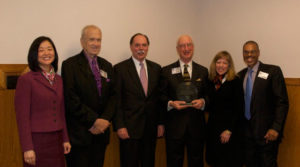
Much of Howard University’s history is about courageous people who put their lives on the line to open the door to opportunity not just for some people but for all. Intellectual property is all about opportunity and the protection of individual rights—opportunity based not on your ethnicity or your sexual preference, or the color of your skin, your religious beliefs, or your station in life, but instead on your creativity, your ingenuity, your intellect, and your abilities. Intellectual property is about opportunity and protecting the creative rights of all people, whoever they might be. In that sense, intellectual property has much in common with the struggle for social justice. I congratulate Howard University and Professor Lateef Mtima, the Founder and Director of the Institute for Intellectual Property and Social Justice, for fifteen years of excellence in educating the future leaders of the intellectual property bar. – Judge Richard Linn
Thoughts from Those There at the Beginning
Read more about the start of the CLE program here.
15 years ago, Howard University School of Law was pretty much an unknown on the IP front. But under the leadership of Professor Mtima and others at Howard, the IP and Social Justice CLE was inaugurated. Outside lawyers and distinguished members of the Judiciary have volunteered their time to the CLE to greatly increase the IP profile of Howard. For me, it has been enormously satisfying to watch this growth. May it continue. – Thomas Irving
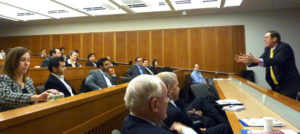
From inspirational vision of Professor Mtima and so many others at Howard University School of Law, we celebrate the 15th Anniversary of IIPSJ’s Annual IP and Social Justice conference. The conference has benefitted from the staunch support of judges, corporate counsels, outside counsels, and of course the fabulous Howard law students. It has been an absolute privilege and honor serving as the Chair of this conference and witnessing its growth over the years. Congratulations on the 15th Anniversary! – Esther Lim
I had the honor of being part of the creation of the Institute and the many wonderful “firsts” - the first CLE program, The first internship at Finnegan Henderson, the first special edition of the law journal, the first visit to the chambers of the CAFC, the first WIPO attendance etc. - It was a tremendous amount of work for an ever evolving cause with countless unanticipated rewards that flow-through my career and life. In fifteen short years, Institute has had an immeasurable impact on a macro and micro level on society, law, lawyers, entrepreneurs, inventors, creators and justice and has enabled me to work to leave a legacy that will inspire future generations. I am forever grateful. – Tameka Simmons
___________________________________________
IP & SOCIAL JUSTICE THROUGH THE YEARS
Through tireless efforts of Prof. Mtima most especially, but also through the supportive and independent efforts of many the others including especially those who have supported and continue to support IIPSJ, the social justice perspective has now worked its way into the very fabric IP discourse and reform at all levels of IP law, policy, advocacy, and administration. I have been most pleased to have been able to contribute to this project for the past 15 years and plan to continue to do so for awhile yet. – Steven Jamar
2007 Intellectual Property and Social Justice Symposium
Introductory Remarks: Applying the Intellectual Property Law in the Public Interest: Copyrights And the Public Use of Software
Presentation: Granting Patents Based On Race: The Practitioner’s Role in Shaping Social Policy
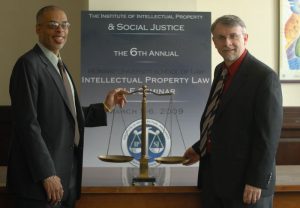
2009 Intellectual Property and Social Justice Symposium Presentation: Where Intellectual Property Theory Meets ‘Outsider’ Jurisprudence–What African-American Cultural Production Can Teach IP Policy

2011 Intellectual Property and Social Justice Symposium Presentation: Intellectual Property and the Pursuit of Civil Rights: Issues & Challenges for the Digital Information Age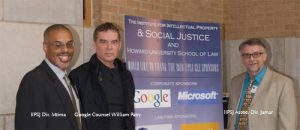
2014 Intellectual Property and Social Justice Luncheon Presentation: Intellectual Property Social Justice: Civil Rights and Economic Empowerment in the 21st
It has been my honor and privilege to participate in Howard’s IP and Social Justice CLE for more than ten years. This is the only CLE of which I am aware that is focused on highlighting the intersection of intellectual property and social justice. It is through this CLE and other work that IIPSJ demonstrates a commitment to ensuring equal access to our intellectual property systems, domestically and abroad. - Toni Y. Hickey
2017 Intellectual Property and Social Justice Luncheon Keynote: Property, Intellectual Property, and Social Justice: Mapping the Next Frontier
CLE Impact & Opportunities
The CLE programs help HUSL alumni and other practitioners develop and maintain expertise in IP practice and provide opportunities for experienced minority IP lawyers to demonstrate their expertise to an audience they might not otherwise reach. The CLE programs also provide networking opportunities for lawyers from diverse groups including attorneys from private practice, from government, from the judiciary, and from academia.
Having attended Howard University School of Law and entered into the IP profession as a patent attorney prior to the establishment of the IP & Social Justice CLE Program, I am so very honored and proud to see the impact that it has had on the students and the IP community as a whole by providing opportunities that previously were hard to come by or not available at all for diverse lawyers in IP law. – Jennifer M. Hayes
As a proud member of the class of 2005… I continue to take pride in this program as an essential element of my continuing legal education. The CLE is uniquely rooted in Howard’s mission of social justice, offering invaluable insights from esteemed members of the bar and bench. I am honored to join the 15th year of this program, and I look forward to returning for many years to come. – Idris McKelvey

The IIPSJ CLE event has been essential in helping to direct the trajectory of my career. Every year I have participated, through the various modules and panel discussions, I walked away with a solid grasp of the current trends in the profession. Moreover, I emerged with an understanding of the future direction of the profession. Thus, I have been able to align my professional experiences with the ever evolving field of Intellectual Property. – Ulysses Williams
I came to Howard Law School with the intent to use my law degree to effect change... Attending the IP & Social Justice CLE program ... I gained a clearer understanding of the intellectual property-related social justice issues not only concerning disenfranchised people in the United States, but around the world. It is an invaluable program and service to the larger community. – Aisha (Williams) Cassis
Prior to attending law school, I spent more than a decade in the biotechnology arena as a scientist. When I entered Howard University School of Law in 2013, I knew that I wanted to be a patent attorney, however, I did not have a strong network of mentors in the patent field. I quickly joined the Howard University School of Law, Intellectual Property Student Association, and benefited from the mentorship of Professor Lateef Mtima. By attending the IP & Social Justice CLE Program each year, I was afforded the unparalleled opportunity to forge new mentoring relationships with practicing attorneys in the IP arena, and learn about emerging IP issues. This unique experience helped guide my career and continues to do so. Currently, I am a second year associate at Finnegan, Henderson, Farabow, Garrett & Dunner, LLP. – Candice R. Jones
Phil Hampton has graciously volunteered his time to participate in the CLE every year.
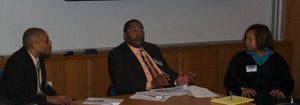
As a student here I benefited from mentoring by Professor Mtima and participation in the CLE, and soon found my passion in the practice of trademark law. By participating as an attorney, I am able to stay up to date and involved with issues of intellectual property and social justice; while continuing the tradition of mentoring the students I meet each year. Congratulations on 15 years and I look forward to the next 15 and many more! – Tashia Bunch
Fair Use & Creative Control
Copyright in the Community: From Fair Use to Creative Control
This month we’d like to discuss some updates in the area of fair use and also invite you to the official launch of Creative Control, the IP community education and pro bono advice initiative.
What is Fair Use?
Fair use is a legal doctrine within the copyright law that allows the public to use copyrighted works and material without the permission of the copyright owner. The fundamental social purpose of copyright protection is to promote the progress of the arts and sciences: to advance American learning and culture by encouraging authors and other creators to share their works with the public. Consequently, copyright reserves to authors only certain specific uses of their works, such as making a copy, while all other uses, such as reading a book aloud as a bed-time story, are freely available to the public. In addition, fair use allows the public to also engage in the authors’ reserved uses, typically referred to as the authors’ exclusive rights, when allowing the activity promotes the social purpose of copyright.
For example, while making a copy of a work is an exclusive right, it would undermine the purpose of copyright if authors could always control whether their work, or any part of their work, can be copied. Without the fair use doctrine, the author of a news article or a history book could prevent a teacher from copying any part of a copyrighted work for use in a classroom discussion. Similar uses by the public, such as reproducing works for purpose of literary or public criticism or social activism, or reproducing portions or aspects of works to create new works such as “fan fiction”, are other activities that are dependent upon fair use.
Fair Use Recent Court Decisions
Some recent court decisions demonstrate the importance of fair use to the creation of new works and art forms and to free speech. In Drake Winning Sampling Case Over Fair Use Is Big News... But Still Demonstrates The Madness Of Music Licensing, Mike Masnick discusses how courts are reevaluating hip-hop sampling as fair use of portions of pre-existing music. In Reaction video YouTubers win landmark ‘fair use’ copyright case in the US,” Heather Gay discusses how a court recently held that a YouTube “reaction video”, video wherein viewers of various Internet videos share their opinions of these works, was protected by fair use.
For more information on how courts have applied fair use, visit the Fair Use Index on the U.S. Copyright Office website. The index is a searchable database of court decisions on fair use compiled to aid the public in understanding the types of uses that have previously been determined to be fair use. For more information on criticism and commentary as fair use, check out “Copy This Podcast Episode 9: Parody Isn’t Always a Laughing Matter.”
Fair Use and Halloween (and other uses…)
In light of the past week’s festivities, you might find interesting a recent op-ed by Joshua Lamel, Fair Use and Halloween, which discusses how fair use supports this All Hallowed American pastime.
Is there an IP social justice development or issue that you think might interest other IIPSJ readers? Please let us know - and as always, we look forward to your comments and questions.
IIPSJ
Creative Control
The Lawyers’ Committee invites you to the launch of Creative Control - an initiative to elevate and empower online expression. The event will feature local DC artists, thought leaders on protecting your creative works, and one-on-one free advice with attorneys.
The event takes place Thursday, November 16 from 7 -10 pm at RedRocks on H St in NE DC.
